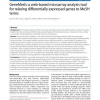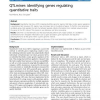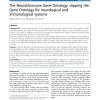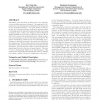160 search results - page 10 / 32 » DIG - a system for gene annotation and functional discovery |
BMCBI
2010
13 years 7 months ago
2010
Background: Genetic interaction profiles are highly informative and helpful for understanding the functional linkages between genes, and therefore have been extensively exploited ...
BMCBI
2010
13 years 7 months ago
2010
Background: An important objective of DNA microarray-based gene expression experimentation is determining interrelationships that exist between differentially expressed genes and ...
BMCBI
2010
13 years 7 months ago
2010
Background: Quantitative trait locus (QTL) mapping identifies genomic regions that likely contain genes regulating a quantitative trait. However, QTL regions may encompass tens to...
BMCBI
2010
13 years 7 months ago
2010
Background: The Gene Ontology (GO) is used to describe genes and gene products from many organisms. When used for functional annotation of microarray data, GO is often slimmed by ...
BMCBI
2007
13 years 7 months ago
2007
Annotating genes and their products with Gene Ontology codes is an important area of research. One approach for doing this is to use the information available about these genes in...




